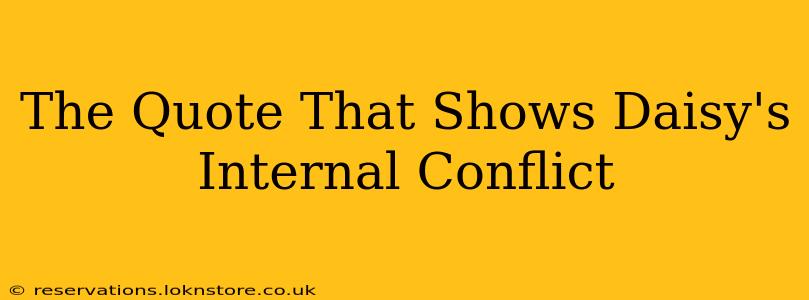The Quote That Shows Daisy Buchanan's Internal Conflict: A Deep Dive into The Great Gatsby
F. Scott Fitzgerald's The Great Gatsby is a masterpiece of character study, and no character is more complex and fascinating than Daisy Buchanan. Her internal conflict, a constant tug-of-war between societal expectations, personal desires, and moral ambiguity, is arguably the novel's central theme. While many quotes highlight her conflicted nature, one stands out as particularly revealing: "That's the best thing a girl can be in this world, a beautiful little fool."
This seemingly simple statement, uttered by Daisy herself, encapsulates the profound internal battle she wages throughout the novel. Let's delve deeper into why this quote perfectly illustrates her inner turmoil and explore related aspects of her character.
What Does This Quote Mean?
On the surface, Daisy's statement appears to be a cynical acceptance of her role in society. She recognizes that beauty and a lack of intellectual depth are highly valued attributes in the Roaring Twenties' social circles she inhabits. By aspiring to be a "beautiful little fool," she's essentially choosing a path of least resistance, allowing her to navigate a world that prioritizes superficiality over substance.
However, a closer reading reveals a deeper layer of self-awareness and regret. The statement isn't simply a declaration of her lifestyle choice; it's a confession of her own limitations and a subtle acknowledgement of the compromises she's made to maintain her privileged position. She is aware that intellectual engagement or genuine emotional depth might threaten her carefully constructed image and her comfortable life.
Is This the Only Quote Showing Daisy's Conflict?
While the "beautiful little fool" quote is particularly potent, other instances throughout the novel also underscore Daisy's internal struggles. Her constant shifting of moods, her manipulative behavior, and her inability to take full responsibility for her actions all point towards a deep-seated conflict. For example, her tearful confession to Gatsby about her love for him is juxtaposed with her immediate return to Tom, demonstrating her inability to reconcile her desires with societal pressures and the reality of her marriage.
What are the Key Aspects of Daisy's Internal Conflict?
Daisy's internal conflict manifests in several key areas:
-
Love vs. Security: The choice between genuine love (for Gatsby) and the security and social status offered by her marriage to Tom is a central theme in Daisy's character arc. She yearns for love and happiness but ultimately prioritizes the perceived security and social advantages of her marriage.
-
Authenticity vs. Societal Expectations: Daisy constantly struggles with the pressure to conform to the societal expectations placed upon women of her class. She tries to present a certain image, often masking her true feelings and desires.
-
Responsibility vs. Avoidance: Daisy consistently avoids taking responsibility for her actions, often manipulating situations to her advantage and escaping the consequences of her choices. This avoidance stems, in part, from her fear of facing the truth about herself and her desires.
-
Past vs. Present: Daisy's past relationship with Gatsby haunts her present, creating a constant tension between her memories of a passionate love and the reality of her unsatisfying marriage.
How Does Daisy's Internal Conflict Drive the Plot?
Daisy's internal conflict is not merely a personal struggle; it significantly drives the plot of The Great Gatsby. Her inability to make a decisive choice between Gatsby and Tom fuels the tragic events that unfold. Her indecisiveness and inability to fully commit to either man ultimately contribute to Gatsby's demise and the overall sense of disillusionment in the novel.
Conclusion
Daisy Buchanan's character is a testament to Fitzgerald's masterful exploration of human complexity. The quote "That's the best thing a girl can be in this world, a beautiful little fool" acts as a keystone, encapsulating the deep-seated internal conflict that defines her character and drives the narrative of The Great Gatsby. It is a statement that speaks volumes about the societal pressures, personal limitations, and tragic choices that shape her life.

